Environmental and Climate Challenges to Agriculture in Poland in the Context of Objectives Adopted in the European Green Deal Strategy
Abstract
1. Introduction
- The identification of current organisational changes observed in agriculture that are particularly important in the context of implementing the European strategy of environmental and climate protection;
- The evaluation of the state of biodiversity protection based on legal forms of the environmental protection of rural areas;
- The assessment of tendencies in greenhouse gas emission of agricultural origin.
2. Theoretical Background
- The use of pesticides. The objective is to reduce the use of chemical pesticides and their risks by 50 percent; more dangerous pesticides should be reduced by 50 percent. The negative impact of pesticide use in agriculture on soil, water and air pollution was identified as a justification for the adopted objectives.
- The use of fertilizers. The objective is to reduce nutrient losses by at least 50 percent without allowing soil fertility to deteriorate and a 20 percent reduction in the use of fertilizers. Nutrient surplus in the environment is an important source of air, soil and water pollution, having a negative impact on biodiversity and climate, which has led to the adoption of targets for rationalizing the management of fertilizers on farms.
- The sale of antimicrobials. In this respect, the objective was to reduce by 50 percent the sales of antimicrobials intended for farmed animals and used in aquaculture. This is due to the increase in the resistance of microorganisms to anti-remedies, resulting from their widespread use in the treatment of animals and humans. The increase in this resilience leads to around 33,000 deaths in the EU every year, which prejudges the need for changes in European agriculture in this area.
- The popularization of organic farming. An ambitious target has been adopted in this area, namely: the area of agricultural land used in accordance with the principles of organic farming should be 25 percent. The adoption of such an ambitious target was determined both by its importance in the conservation of environmental resources (environmentally friendly agricultural practices) and its positive impact on the climate and biodiversity. The implementation of the Farm to Fork strategy should contribute to the application of solutions that fit into the circular economy.
3. Materials and Methods
3.1. Evaluation of Agriculture Organization
3.2. Biodiversity Evaluation
3.3. Evaluation of Climate Aspect of Agriculture
4. Results
4.1. The General Data about Agriculture
4.2. Agriculture vs. Farm to Fork Strategy
4.3. Biodiversity Protection Based on Legal Rules
4.4. Climate Challenges to Agriculture in Poland Based on Tendencies in Greenhouse Gas Emissions and the European Green Deal Objectives
5. Discussion
- -
- changes at the level of the EU climate policy;
- -
- inadequate emissions monitoring system;
- -
- difficulties in estimating the propensity of farmers to implement low-carbon practices.
6. Conclusions
- The strategic goals presented in the European Green Deal, the Farm to Fork strategy and the Strategy of Biodiversity are very ambitious in the 2030 perspective, but still, based on observed environmental and climate changes, the defined goal is justified, as is undertaking activities that will mitigate and adapt agriculture to new external conditions.
- Based on the presented direction of the development of Polish agriculture, we can observe that the process of specialization and farming concentration will require specific practices aimed at achieving strategic European goals achievement.
- Taking into consideration strategic goals connected with pesticide, fertilizer and antibiotic management, their limited use, as well as the implementation of more rational practice application at the sector level, will be some organizational challenge for agriculture. However, it is worth mentioning that the point of reference in this transformation will be very important (e.g., established year as the starting point in measuring the achievement of strategic goals; the level of goal achievement—a farm, some farming types or the country/sector level; an average recommended value to achieve for Europe in total or individual threshold for each European country). However, each strategic goal can be a serious challenge for the specific farm groups; in the case of pesticide limitation—for farms specialized in permanent crops; fertilizer management—for farms with intensive crop production; and antibiotics—especially for specialized farms with the huge scale of livestock production. It is worth underlining that organic production development at the sector level will be the grave challenge for the sector because of its niche significance on the agricultural market, which results from social awareness and profitability.
- Taking into consideration the previous direction of agricultural development, additional policy initiatives are required to effectively transform the sector towards environmental sustainability.
- Poland has a significant potential of areas with high natural value. First of all, this is indicated by the share of the Natura 2000 areas in the total area and the HNVfs areas in the total UAA. In addition, many areas dedicated to biodiversity protection are also outside of these areas. This is evidenced by the high values on the NTVI index of many gminas in Poland. This indicator, expressed as the share of valued environmental components, such as permanent grasslands, forests, water reservoirs and other areas not subject to anthropopressure in total area located in adjacent of UAA in gminas, shows Poland’s potential to increase the importance of areas supporting biodiversity by 2030. However, much will depend primarily on future actions undertaken in the agricultural sector aimed at their protection.
- In Poland, there is still a process of biodiversity decline in many areas related to agriculture. In the agricultural sector, there is an urgent need for more care for their condition. However, it should be noted that by taking additional measures for support of biodiversity, this sector will face the challenge of their implementation without losing productivity and effectiveness in conditions of increasing competitive pressure from other EU countries.
- Meeting the Community’s commitments to reduce greenhouse gas emissions will require an enormous effort. It is related to the need to reverse the existing trends, as agriculture in Poland so far has been characterised by increasing emissions of these gases. As a result, the change is much more profound than the Community findings suggest.
- Meeting the target is likely to require a change in the method of collecting data on GHG emissions and the way they are reported to include low-carbon agricultural practices. Under the current system, emissions depend mainly on the number of animals and the cultivated area, rather than on management practices.
Author Contributions
Funding
Conflicts of Interest
References
- European Commission. Communication from the Commmission to the European Parliament, The European Council, The Council, The European Economic and Social Commmittee and The Commmittee of the Regions, The European Green Deal; European Commission: Brussels, Belgium, 2019. [Google Scholar]
- European Commission. Communication from the Commmission to the European Parliament, The European Council, The Council, The European Economic and Social Commmittee and The Commmittee of the Regions, Farm to Fork Strategy for a Fair, Healthy and Environmentally-Friendly Food System; European Commission: Brussels, Belgium, 2020. [Google Scholar]
- European Commission. Communication from the Commission to the European Parliament, The Council, The European Economic and Social Committee and The Committee of the Regions, EU Biodiversity Strategy for 2030; European Commission: Brussels, Belgium, 2020. [Google Scholar]
- European Commission. Communication from the Commission to the European Parliament, The Council, The European Economic and Social Committee, The Committee of the Regions and European Investment Bank. A Clean Planet for All a European Strategic Long-Term Vision for a Prosperous, Modern, Competitive and Climate Neutral Economy; European Commission: Brussels, Belgium, 2018. [Google Scholar]
- Eurostat. Air Emissions Accounts by NACE Rev. 2 Activity (env_ac_ainah_r2). Available online: https://ec.europa.eu/eurostat/databrowser/view/env_ac_ainah_r2/default/table?lang=en (accessed on 15 April 2020).
- European Commission. Regulation of the European Parliament and of the Council Establishing Rules on Support for Strategic Plans to be Drawn Up by Member States under the Common Agricultural Policy (CAP Strategic Plans) and Financed by the European Agricultural Guarantee Fund (EAGF) and by the European Agricultural Fund for Rural Development (EAFRD) and repealing Regulation (EU) No 1305/2013 of the European Parliament and of the Council and Regulation (EU) No 1307/2013 of the European Parliament and of the Council; European Commission: Brussels, Belgium, 2018. [Google Scholar]
- IPCC. Climate Change 2013: The Physical Science Basis Working Group I Contribution to the IPCC 5th Assessment Report Intergovernmental Panel on Climate Change; IPCC: Geneva, Switzerland, 2013. [Google Scholar]
- European Commission. Communication from the Commission to the European Parliament, The Council, The European Economic and Social Committee and The Committee of the Regions. Forging a Climate-Resilient Europe—The New EU Strategy on Adaptation to Climate Change; European Commission: Brussels, Belgium, 2021. [Google Scholar]
- Houghton, J. Global Warming, 3rd ed.; Cambridge University Press: Cambridge, UK, 2004. [Google Scholar]
- Cowie, J. Climate Change, Biological and Human Aspects; Cambridge University Press: Cambridge, UK, 2007. [Google Scholar]
- Czyżewski, A.; Henisz, A. Ekonomia czynnika ziemi i jej współczesne znaczenie. In Współczesne Problemy Agrobiznesu w Polsce; Czyżewski, A., Ed.; Akademia Ekonomiczna w Poznaniu: Poznań, Poland, 2001; pp. 33–36. [Google Scholar]
- Błąd, M. Kulturowe funkcje wsi i rolnictwa. In Wielofunkcyjność Rolnictwa: Kierunki Badań, Podstawy Metodologiczne i Implikacje Praktyczne; Wilkin, J., Ed.; Instytut Rozwoju Wsi i Rolnictwa Polskiej Akademii Nauk: Warszawa, Poland, 2010; pp. 165–170. [Google Scholar]
- Wilkin, J. Wielofunkcyjność Rolnictwa. Kierunki Badań, Podstawy Metodologiczne i Implikacje Praktyczne; Instytut Rozwoju Wsi i Rolnictwa Polskiej Akademii Nauk: Warszawa, Poland, 2010. [Google Scholar]
- Singh, J.S.; Pandey, V.C.; Singh, D.P. Efficient soil microorganisms: A new dimension for sustainable agriculture and environmental development. Agric. Ecosyst. Environ. 2011, 140, 339–353. [Google Scholar] [CrossRef]
- Manteuffel, R. Filozofia Rolnictwa; PWN: Warszawa, Poland, 1987. [Google Scholar]
- IPBES. Available online: https://ipbes.net/news/ipbes-global-assessment-preview (accessed on 17 March 2020).
- European Commission. Report from The Commission to The European Parliament and The Council the Mid-Term Review of The EU Biodiversity Strategy to 2020; European Commission: Brussels, Belgium, 2015. [Google Scholar]
- Jeliazkov, A.; Mimet, A.; Charge, A.; Jiguet, F.; Devictor, V.; Chiron, F. Impacts of agricultural intensification on bird communities: New insights from a multi-level and multi-facet approach of biodiversity. Agric. Ecosyst. Environ. 2016, 216, 9–22. [Google Scholar] [CrossRef]
- Nieto, A.; Roberts, S.P.M.; Kemp, J.; Rasmont, P.; Kuhlmann, M.; García Criado, M.; Biesmeijer, J.C.; Bogusch, P.; Dathe, H.H.; De Meulemeester, T.; et al. European Red List of Bees; European Commission: Brussels, Belgium, 2014. [Google Scholar]
- Stoate, C.; Baldi, A.; Beja, P.; Boatman, N.D.; Herzon, I.; van Doorn, A.; de Snoo, G.R.; Rakosy, L.; Ramwell, C. Ecological impact of early 21st century agricultural change in Europe—A review. J. Environ. Manag. 2009, 91, 22–46. [Google Scholar] [CrossRef] [PubMed]
- Strohbach, M.W.; Kohler, M.L.; Dauber, J.; Klimek, S. High Nature Value farming: From indication to conservation. Ecol. Indic. 2016, 57, 557–563. [Google Scholar] [CrossRef]
- European Commission. Practices to Identify, Monitor and Assess HNV Farming in RDPs 2014–2020; Working Document; Directorate-General for Agriculture and Rural Development: Brussels, Belgium, 2016. [Google Scholar]
- European Commission. Technical Handbook on the Monitoring and Evaluation Framework of the Common Agricultural Policy 2014–2020; Directorate-General for Agriculture and Rural Development: Brussels, Belgium, 2017. [Google Scholar]
- Jadczyszyn, J.; Zieliński, M. Assessment of farms from High Nature Value Farmland areas in Poland. Ann. PAAAE 2020, XXII, 3. [Google Scholar] [CrossRef]
- European Union. Regulation (EU) 2018/842 of The European Parliament and of The Council of 30 May 2018 on Binding Annual Greenhouse Gas Emission Reductions by Member States from 2021 to 2030 Contributing to Climate Action to Meet Commitments under the Paris Agreement and Amending Regulation (EU) No 525/2013; L 156/26-42; European Union: Maastricht, The Netherlands, 2018. [Google Scholar]
- IPCC. Climate Change 2014: Mitigation of Climate Change. Contribution of Working Group III to the Fifth Assessment Report of the Intergovernmental Panel on Climate Change; Edenhofer, O.R., Pichs-Madruga, Y., Sokona, E., Farahani, S., Kadner, K., Seyboth, A., Adler, I., Baum, S., Brunner, P., Eickemeier, B., et al., Eds.; Cambridge University Press: Cambridge, UK, 2018. [Google Scholar]
- IPCC-Intergovernmental Panel on Climate Change. IPCC Guidelines for National Greenhouse Gas Inventories, National Greenhouse Gas Inventories Programme. 2006. Available online: http://www.ipcc-nggip.iges.or.jp/public/2006gl/vol4.html (accessed on 12 May 2021).
- Siekierski, C. Uwarunkowania rozwoju polskiego rolnictwa w kontekście zmian ustrojowych, integracji z UE oraz ewolucji wspólnej polityki rolnej. Zagadnienia Ekonomiki Rolnej 2020, 1, 122–137. [Google Scholar]
- European Environment Agency. The European Environment—State and Outlook 2020: Knowledge for Transition to a Sustainable Europe; Publications Office of the European Union: Luxembourg, 2019. [Google Scholar]
- EMA-European Medicines Agency. Sales of Veterinary Antimicrobial Agents in 25 EU/EEA Countries in 2011; Third ESVAC report; European Medicines Agency: Amsterdam, The Netherlands, 2013. [Google Scholar]
- EMA-European Medicines Agency. Sales of Veterinaty Antimicrbial Agents in 31 European Countries in 2018, Trends from 2010 to 2018; Tenth ESVAC Report; European Medicines Agency: Amsterdam, The Netherlands, 2020. [Google Scholar]
- Zalewski, A. Rynek środków Produkcji dla Rolnictwa; Stan i perspektywy, Analizy Rynkowe; IERiGŻ-PIB: Warszawa, Poland, 2007; Available online: https://ierigz.waw.pl/publikacje/analizy-rynkowe/rynek-srodkow-produkcji-dla-rolnictwa/1936,4,3,0,1320093637.html (accessed on 20 June 2021).
- Zalewski, A. Rynek środków Produkcji dla Rolnictwa; Stan i perspektywy, Analizy Rynkowe; IERiGŻ-PIB: Warszawa, Poland, 2020; Available online: https://ierigz.waw.pl/publikacje/analizy-rynkowe/rynek-srodkow-produkcji-dla-rolnictwa/23648,4,3,0,nr-47-2020-rynek-srodkow-produkcji-dla-rolnictwa.html (accessed on 20 June 2021).
- Zomeni, M.; Martinou, A.F.; Stavrinides, M.C.; Vogiatzakis, I.N. High nature value farmlands: Challenges in identification and interpretation using Cyprus as a case study. Nat. Conserv. 2018, 31, 53–70. [Google Scholar] [CrossRef]
- Hünig, C.; Benzler, A. Das Monitoring der Landwirtschaftsflachen mit hohem Naturwert in Deutchland; BfN-Skripten 476; The German Federal Agency for Nature Conservation (Bundesamt für Naturschutz): Bonn, Germany, 2017. [Google Scholar]
- Benzler, A. Drawing on national experience for identifying HNV farmland at European scale: HNV farmland monitoring. In Proceedings of the Expert Workshop Revising the JRC/EEA EU-Level HNV Farmland Methodology, Vienna, Germany, 12 June 2017. [Google Scholar]
- Łopatka, A.; Koza, P.; Siebielec, G. Propozycja Metodyki Wydzieleń Zasięgów Obszarów ONW Typ Specyficzny Wg Tzw. Kryteriów Krajowych; IUNG-Instytut Uprawy Nawożenia i Gleboznawstwa: Puławy, Poland, 2017. [Google Scholar]
- Zieliński, M.; Sobierajewska, J. Functioning of farms from areas of High Natural Values at the background of other farms. Probl. Agric. Econ. 2018, 356, 3. [Google Scholar] [CrossRef]
- Zieliński, M.; Łopatka, A.; Koza, P. Assessment of the Functioning of Farms in Less-Favored Areas and in Areas of Significant Natual Value (LFA Specific type Zone I). Probl. Agric. Econ. 2020, 364, 3. [Google Scholar]
- Ministerstwo Rolnictwa i Rozwoju Wsi. Program Rozwoju Obszarów Wiejskich; MRiRW-Ministerstwo Rolnictwa i Rozwoju Wsi: Warszawa, Poland, 2021.
- European Commission. Updated Guidelines for Applying Common Criteria to Identify Agricultural Areas with Natural Constraints; Joint Research Centre: Brussels, Belgium, 2016. [Google Scholar]
- Matyka, M.; Jugowar, J.L.; Kowalczyk, A.; Kozyra, J.; Łopatka, A.; Piórkowski, H.; Radzikowski, P.; Siebielec, G. Ocena Rezultatów Wdrażania Programu Rozwoju Obszarów Wiejskich na Lata 2014–2020 w Latach 2014–2018; Zadanie II-środowisko i klimat. Raport końcowy; MRiRW-Ministerstwo Rolnictwa i Rozwoju Wsi: Warszawa, Poland, 2019.
- Rozporządzenie Ministra Rolnictwa i Rozwoju Wsi z Dnia 1 Lutego 2019 r Zmieniające Rozporządzenie w Sprawie Szczegółowych Warunków i Trybu Przyznawania Pomocy Finansowej w Ramach Działania “Płatności dla Obszarów z Ograniczeniami Naturalnymi lub Innymi Szczególnymi Ograniczeniami” Objętego Programem Rozwoju Obszarów Wiejskich na lata 2014-2020. Dz. U 2019 poz. 262. Available online: http://isap.sejm.gov.pl/isap.nsf/DocDetails.xsp?id=WDU20190000262 (accessed on 20 June 2021).
- Dudek, M.; Wrzaszcz, W. On the Way to Eco-Innovations in Agriculture: Concepts, Implementation and Effects at National and Local Level. The Case of Poland. Sustainability 2020, 12, 4839. [Google Scholar] [CrossRef]
- Goraj, L.; Bocian, M.; Cholewa, I.; Nachtman, G.; Tarasiuk, R. Współczynniki Standardowej Produkcji “2007” dla Celów Wspólnotowej Typologii Gospodarstw Rolnych; Instytut Ekonomiki Rolnictwa i Gospodarki Żywnościowej-Państwowy Instytut Badawczy (IERiGZ-PIB): Warszawa, Poland, 2012. [Google Scholar]
- Wrzaszcz, W.; Kopiński, J. Gospodarka Nawozowa Gospodarstw Indywidualnych w Polsce w Kontekście Ochrony Środowiska; Studia i Monografie nr 178; Instytut Ekonomiki Rolnictwa i Gospodarki Żywnościowej-Państwowy Instytut Badawczy (IERiGZ-PIB): Warszawa, Poland, 2019. [Google Scholar]
- Ustawa z Dnia 16 Kwietnia 2004 r. o Ochronie Przyrody, Dz.U. 2004 Nr 92, poz.880. Available online: https://isap.sejm.gov.pl/isap.nsf/DocDetails.xsp?id=WDU20040920880 (accessed on 20 June 2021).
- European Commission. Natura 2000: Nature and Biodiversity Newsletter; European Commission: Brussels, Belgium, 2020; p. 48. [Google Scholar]
- Generalny Dyrektor Ochrony Środowiska. Realizacja Dyrektywy Ptasiej i Dyrektywy Siedliskowej; Generalny Dyrektor Ochrony Środowiska: Warszawa, Poland, 2017.
- GDOŚ. Natura 2000 w Polsce. Available online: https://natura2000.gdos.gov.pl/natura-2000-w-polsce (accessed on 12 September 2019).
- GIOŚ. Wskaźnik Liczebności Ptaków Krajobrazu Rolniczego. Available online: http://www.monitoringptakow.gios.gov.pl/ptaki-krajobrazu-rolnego (accessed on 19 August 2019).
- GUS-Statistics Poland. Rocznik Statystyczny Rolnictwa/Statistical Yearbook of Agriculture; Główny Urząd Statystyczny/Statistics: Warsaw, Poland, 2018.
- MRiRW. Diagnoza Sektora Rolno-Spożywczego i Obszarów Wiejskich w Polsce Przygotowana dla Potrzeb Opracowania Planu Strategicznego Wspólnej Polityki Rolnej na Lata 2023–2027; Ministerstwo Rolnictwa i Rozwoju Wsi: Warszawa, Poland, 2020.
- Europejski Trybunał Obrachunkowy. Należy dołożyć starań, by wdrożyć sieć Natura 2000 z pełnym wykorzystaniem jej potencjału; Europejski Trybunał Obrachunkowy: Luksemburg, 2017. [Google Scholar]
- Baza Danych Obszarów Natura 2000 w Polsce. GDOŚ, IUNG–PIB. Available online: https://www.gdos.gov.pl/baza-danych (accessed on 24 August 2018).
- Adamski, M.; Jarzębowski, S.; Józwiak, W.; Kagan, A.; Mirkowska, Z.; Skarżyńska, A.; Sobierajewska, J.; Zieliński, M.; Ziętara, W.; Żekało, M.; et al. Przedsiębiorstwo i Gospodarstwo Rolne Wobec Zmian Klimatu i Polityki Rolnej; Monografie Programu Wieloletniego; Instytut Ekonomiki Rolnictwa i Gospodarki Żywnościowej-Państwowy Instytut Badawczy (IERiGZ-PIB): Warszawa, Poland, 2019. [Google Scholar]
- Benedetti, Y. Trends in High Nature Value farmland studies: Asystematic review. Eur. J. Ecol. 2017, 3, 19–32. [Google Scholar] [CrossRef]
- Gardi, C.; Visioli, G.; Conti, F.D.; Scotti MMenta, C.; Bodini, A. High Nature Value Farmland: Assessment of Soil Organic Carbon in Europe. Front. Environ. Sci. 2016, 4, 47. [Google Scholar] [CrossRef]
- Jadczyszyn, J.; Kopiński, J.; Kuś, J.; Łopatka, A.; Madej, A.; Matyka, M.; Musiał, W.; Siebielec, G. Rolnictwo na Obszarach Specyficznych. Powszechny Spis Rolny 2010; GUS-Statistics Poland: Warszawa, Poland, 2013.
- IMGW. Klimat; Instytut Meteorologii i Gospodarki Wodnej–Państwowy Instytut Badawczy: Warszawa, Poland, 2019. Available online: https://www.imgw.pl/badania-nauka/klimat (accessed on 19 December 2020).
- IPCC. Global Warming of 1.5 °C. An. IPCC Special Report on the Impacts of Global Warming of 1.5 °C above Pre-Industrial Levels and Related Global Greenhouse Gas Emission Pathways, in the Context of Strengthening the Global Response to the Threat of Climate Change, Sustainable Development, and Efforts to Eradicate Poverty; Masson-Delmotte, V., Zhai, P., Pörtner, H.-O., Roberts, D., Skea, J., Shukla, P.R., Pirani, A., Moufouma-Okia, W., Péan, C., Pidcock, R., et al., Eds.; IPCC: Geneva, Switzerland, 2018. [Google Scholar]
- IMGW. IMGW-PIB Raport: Klimat w Polsce—Lipiec. 2021. Available online:https://www.imgw.pl/wydarzenia/imgw-pib-raport-klimat-w-polsce-lipiec-2021 (accessed on 23 August 2021).
- IUNG. System Monitoringu Suszy Rolniczej. Komentarz Agrometeorologa. Available online: http://www.susza.iung.pulawy.pl/komentarz/ (accessed on 24 August 2021).
- GUS. Informacja o Wstępnych Wynikach Powszechnego Spisu Rolnego 2020; Główny Urząd Statystyczny/Statistics: Warszawa, Poland, 2021.
- Ministry of Climate. Poland’s National Inventory Report 2020; Ministry of Climate: Warsaw, Poland, 2020.
- KOBiZE. Czwarty Raport Dwuletni dla Konwencji Stron Ramowej Konwencji Narodów Zjednoczonych w Sprawie Zmian Klimatu; KOBiZE, IOŚ-PIB: Warszawa, Poland, 2020. [Google Scholar]
- European Commission. Commission/implementing Decision (EU) 2020/2126 of 16 December 2020 on setting out the annual emission allocations of the Member States for the period from 2021 to 2030 pursuant to Regulation (EU) 2018/842 of the European Parliament and of the Council; European Commission: Brussels, Belgium, 2020. [Google Scholar]
- Pandian, S.; Ramesh, M. Development of Pesticide Resistance in Pests. A Key Challenge to the Crop Protection and Environmental Safety. In Pesticides in Crop Production: Physiological and Biochemical Action; Srivastava, P.K., Singh, V.P., Singh, A., Tripathi, D.K., Singh, S., Prasad, S.M., Chauhan, D.K., Eds.; Wiley: Hoboken, NJ, USA, 2020. [Google Scholar]
- Rakshit, A.; Singh, H.B.; Sen, A. Nutrient Use Efficiency: From Basics to Advances; Springer: Berlin/Heidelberg, Germany, 2015. [Google Scholar]
- European Medicines Agency; Committee for Medicinal Products for Veterinary use (CVMP); Committee for Medicinal Products for Human Use (CHMP). Categorisation of Antibiotics in the European Union; EMA/CVMP/CHMP/682198/2017; European Medicines Agency: Amsterdam, The Netherlands, 2019. [Google Scholar]
- Nachtman, G. Sytuacja Produkcyjno-Ekonomiczna Gospodarstw Ekologicznych w Polsce w Latach 2013–2018; Studia i monografie, Nr 181; IERiGŻ-PIB: Warszawa, Poland, 2021. [Google Scholar]
- GIOŚ. Stan środowiska w Polsce; Raport 2014; Główny Inspektorat Ochrony Środowiska: Warszawa, Poland, 2014. Available online: http://www.gios.gov.pl/images/dokumenty/pms/raporty/GIOS_raport_2014.pdf (accessed on 20 June 2021).
- GIOŚ. Stan środowiska w Polsce; Raport 2018; Główny Inspektorat Ochrony Środowiska: Warszawa, Poland, 2018. Available online: https://www.researchgate.net/publication/330105270_Stan_srodowiska_w_Polsce_Raport_2018 (accessed on 20 June 2021).
- GIOŚ. Available online: https://monitoringptakow.gios.gov.pl/ptaki-krajobrazu-rolniczego.html (accessed on 25 March 2021).
- Chylarecki, P.; Chodkiewicz, T.; Neubauer, G.; Sikora, A.; Meissner, W.; Woźniak, B.; Wylegała, P.; Ławicki, Ł.; Marchowski, D.; Betleja, J.; et al. Trendy Liczebności Ptaków w Polsce; GIOŚ: Warszawa, Poland, 2018.
- EEA. Available online: https://www.eea.europa.eu/data-and-maps/indicators/abundance-and-distribution-of-selected-species-9/assessment (accessed on 12 May 2021).
- Eurostat. Available online: http://appsso.eurostat.ec.europa.eu/nui/show.do?dataset=env_bio2&lang=en (accessed on 12 May 2021).
- CAKE-Centrum Analiz Klimatyczno-Energetycznych. Zmiana Celów Redukcyjnych Oraz cen Uprawnień do Emisji Wynikająca z Komunikatu “Europejski Zielony Ład”. In Centre for Climate and Energy Analyses, Krajowy Ośrodek Bilansowania i Zarządzania Emisjami; Instytut Ochrony Środowiska–Państwowy Instytut Badawczy: Warszawa, Poland, 2020. [Google Scholar]
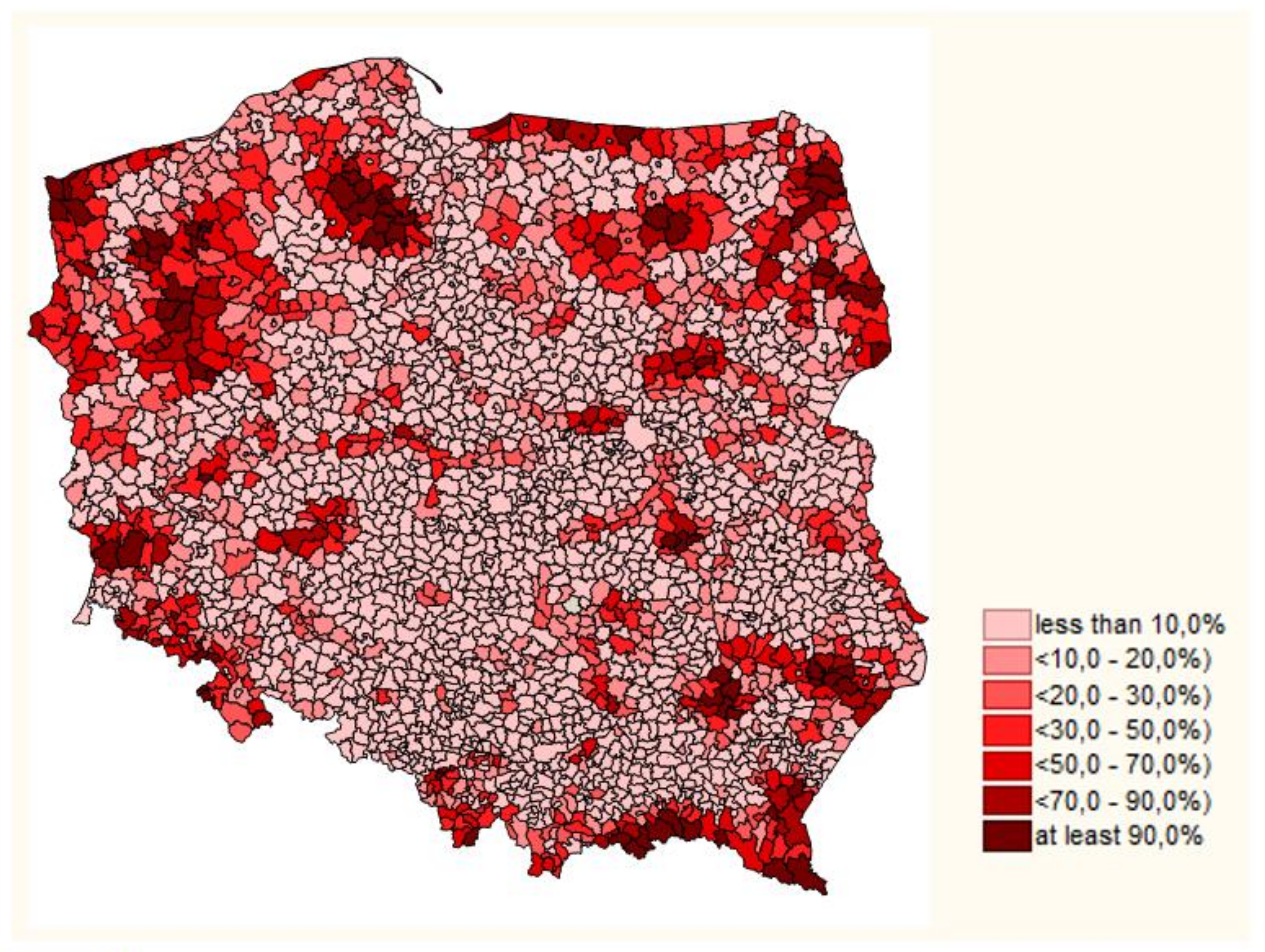
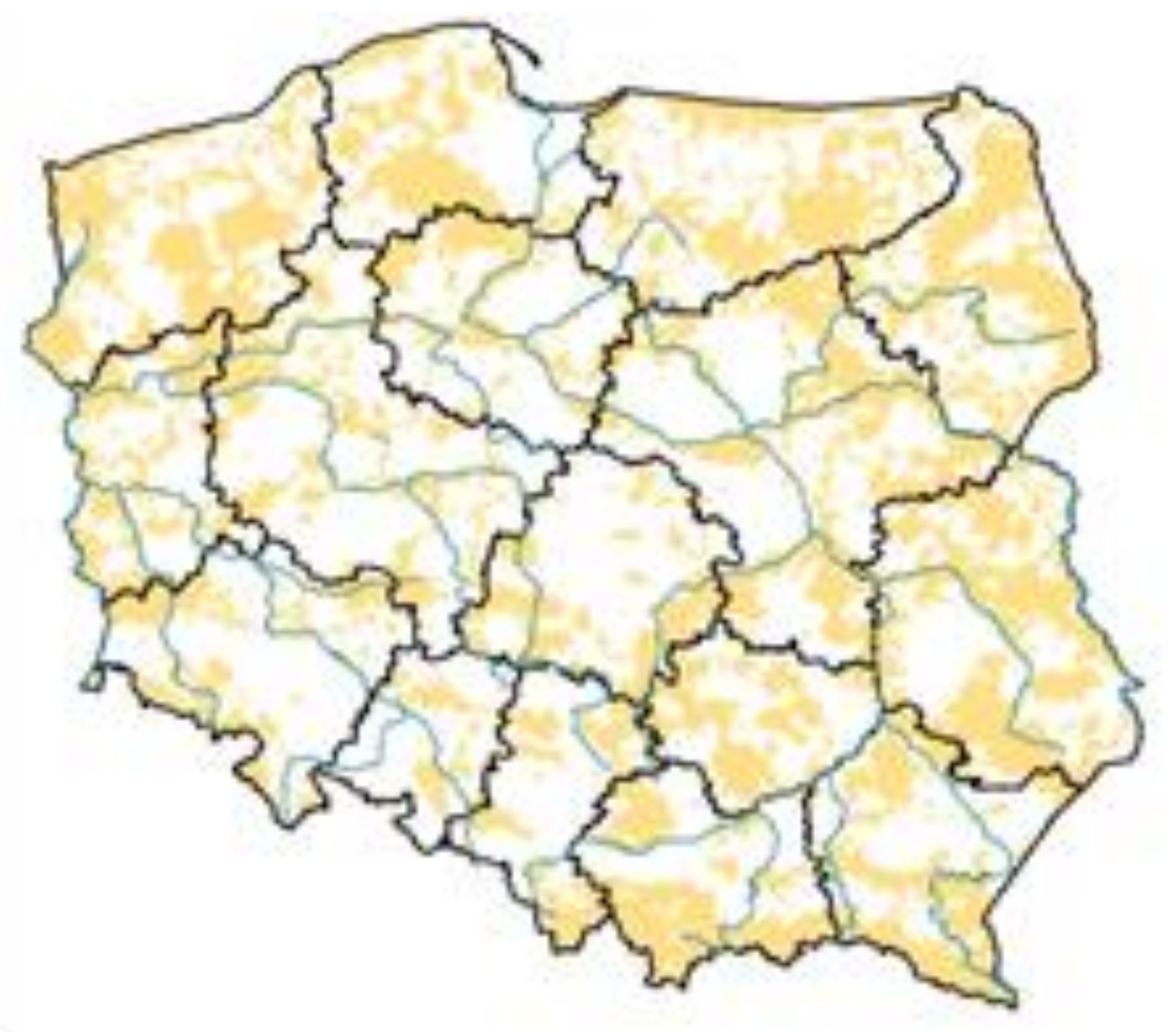

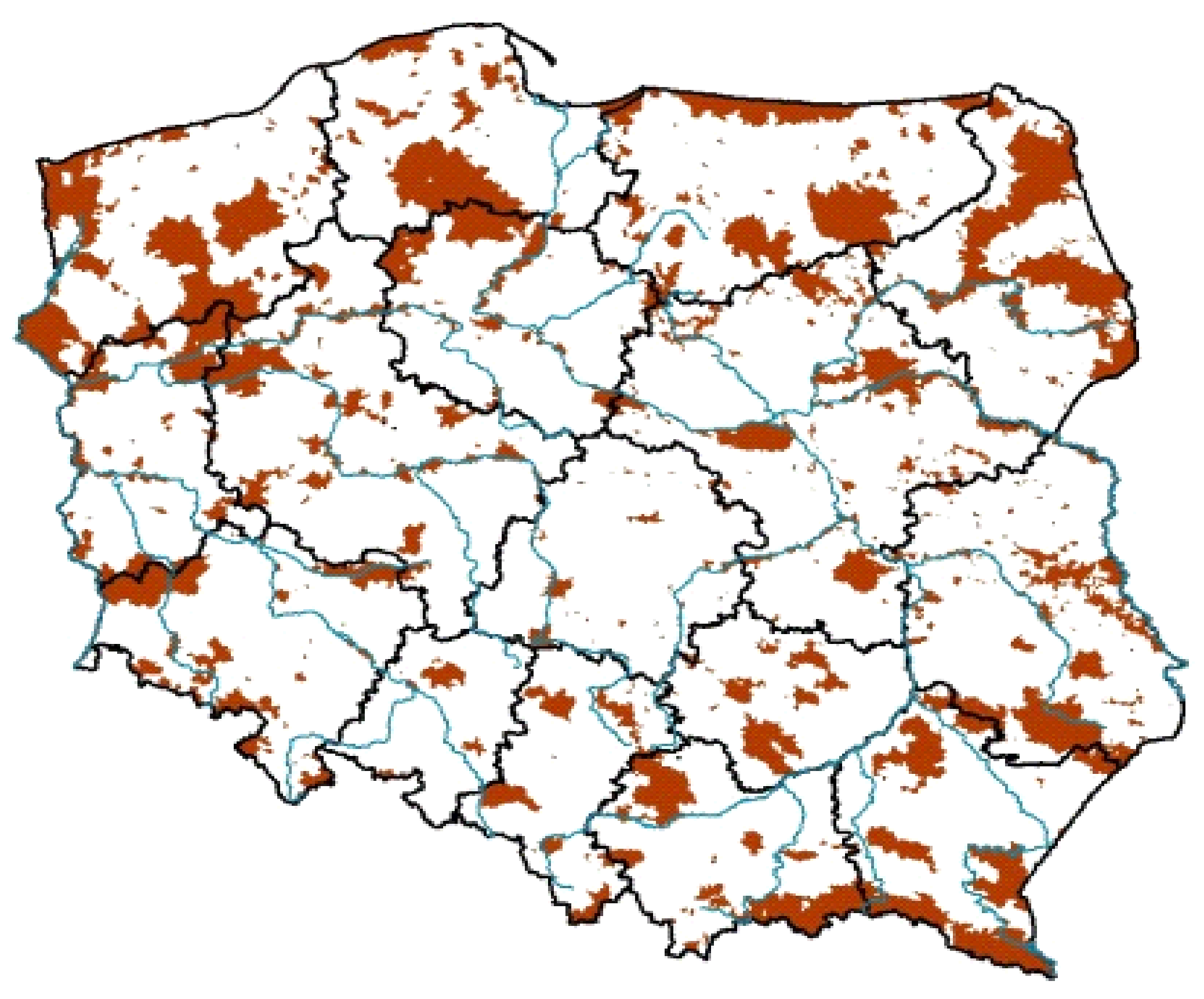
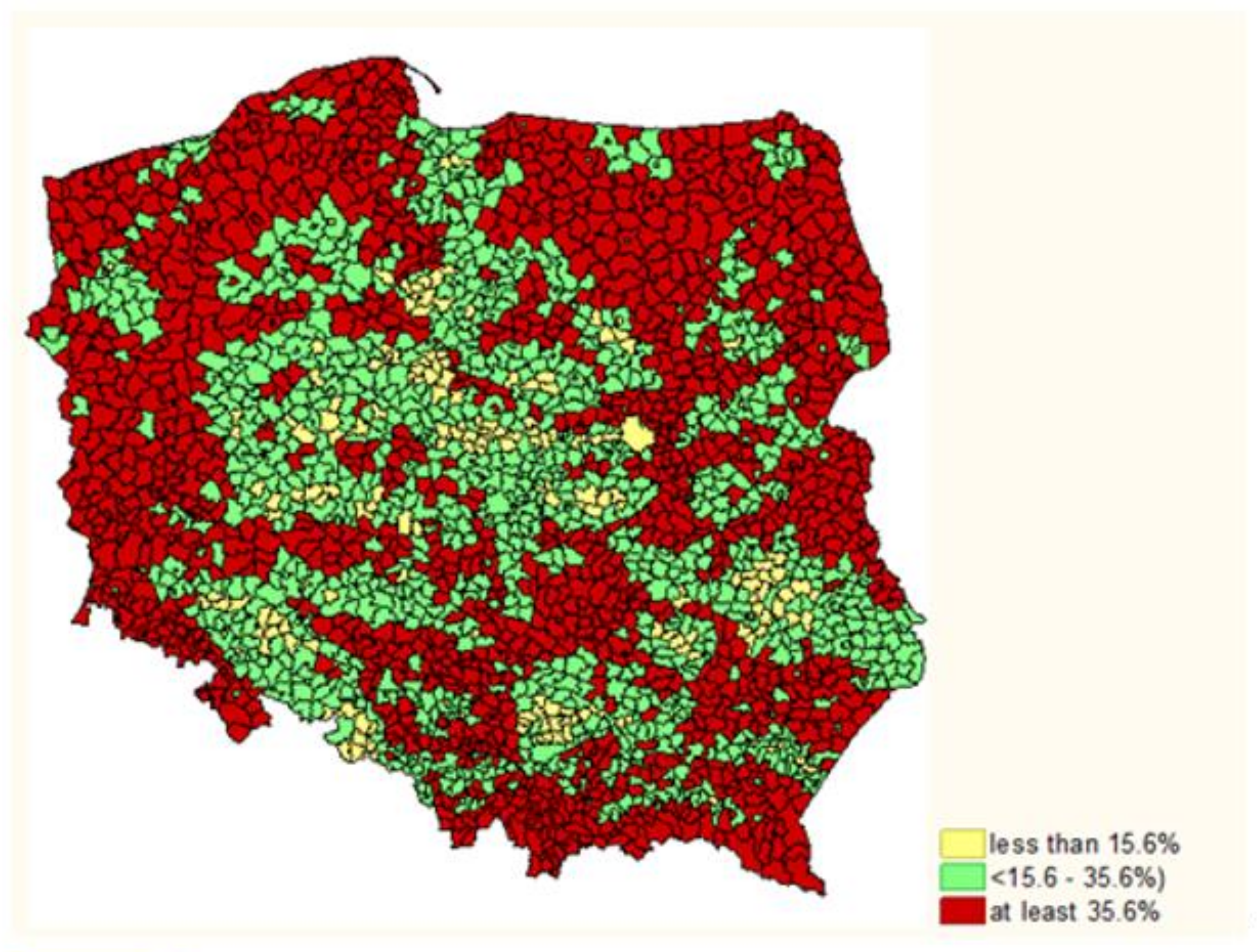
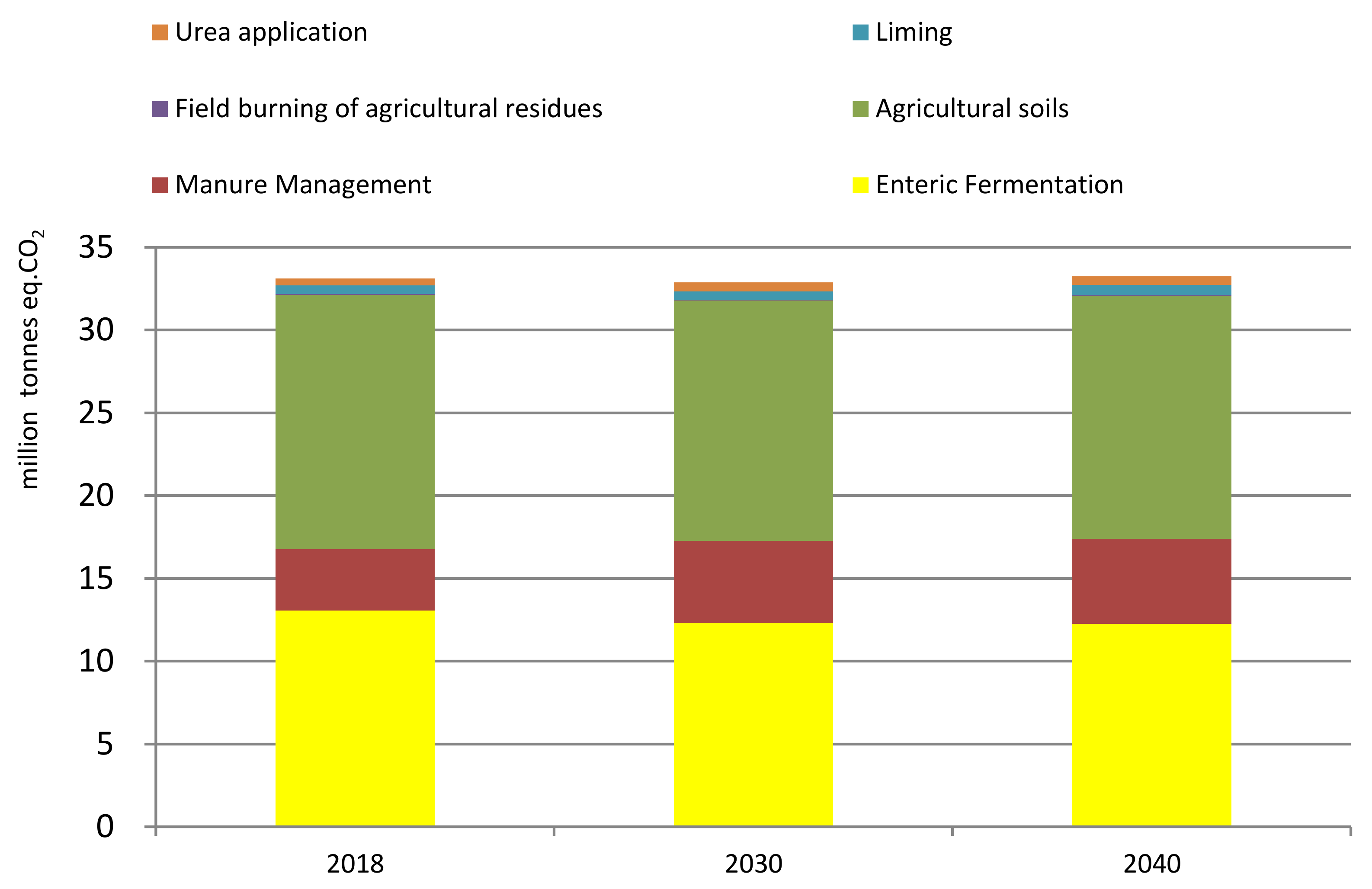
| No. | Specification | Analysed Period | Change in: | ||
|---|---|---|---|---|---|
| Units | % | ||||
| 1. | Pesticides in agriculture | 2005 | 2016 | 2016-05 | 2016/05 |
| 1.1 | Crop protection products’ use (in thousand tonnes of active substance) | 16.0 | 25.5 | 9.5 | 59.0 |
| 1.2 | Crop protection products’ use/crops (kg of active substance/ha) | 1.3 | 2.2 | 0.9 | 71.5 |
| 1.3 | Farms without chemicals in crop production (% of farms in total) | # | 33.9 | # | # |
| 1.4 | Farms specialized in crop production (% of farms in total) | 45.4 | 63.6 | 18.2 | # |
| 2. | Fertilizers in agriculture | 2007 | 2016 | 2016-07 | 2016/07 |
| 2.1 | The average balance of N (kg/ha) | 43.8 | 33.0 | −10.8 | −24.7 |
| 2.2 | The average balance of P (kg/ha) | 5.7 | −0.4 | −6.1 | x |
| 2.3 | The average balance of K (kg/ha) | 8.2 | −0.5 | −8.7 | x |
| 2.4 | Effectiveness of N use (%) | 63.3 | 72.9 | 9.6 | x |
| 2.5 | Effectiveness of P use (%) | 71.0 | 102.2 | 31.2 | x |
| 2.6 | Effectiveness of K use (%) | 86.5 | 100.7 | 14.2 | x |
| 2.7 | Farms with excessive balance of N (% of total farms) | 27.4 | 20.5 | −6.9 | x |
| 2.8 | Farms with excessive balance of P (% of total farms) | 40.8 | 22.0 | −18.8 | x |
| 2.9 | Farms with excessive balance of K (% of total farms) | 30.1 | 25.6 | −4.5 | x |
| 2.10 | Farms with mineral fertilization (% of total farms) | 83.6 | 75.9 | −7.7 | x |
| 2.11 | Mineral fertilization per farm (N in kg/ha) | 64.9 | 69.6 | 4.7 | 7.2 |
| 2.12 | Mineral fertilization per farm (P2O5 in kg/ha) | 26.2 | 22.4 | −3.8 | −14.5 |
| 2.13 | Mineral fertilization per farm (K2O in kg/ha) | 30.9 | 36.0 | 5.1 | 16.5 |
| 2.14 | Farms with natural fertilization (% of total farms) | 62.6 | 48.1 | −14.5 | x |
| 3. | Livestock production and antimicrobials for farmed animals | ||||
| Livestock sector | 2005 | 2016 | 2016-05 | 2016/05 | |
| 3.1 | Livestock population (in thousand LU 1) | 6779.3 | 5923.5 | −855.8 | −12.6 |
| 3.2 | Farms with livestock production (%) | 72.4 | 51.0 | −21.4 | x |
| 3.3 | Farms specialised in livestock production (%) | 12.6 | 13.3 | 0.7 | x |
| 3.4 | Farms with high density—LU/ha above 2 (%) | 1.28 | 2.24 | 0.96 | x |
| Antimicrobials for farmed animals | 2011 | 2018 | 2018-11 | 2018/11 | |
| 3.4 | Estimated PCU 2 (in thousand tonnes) | 3929 | 4672 | 743.0 | 18.9 |
| 3.5 | Sale of veterinary antimicrobial agents (mg/PCU) | 126.2 | 167.4 | 41.2 | 32.6 |
| 3.6 | Sale of 3rd- and 4th-generation cephalosporins (B category) (mg/PCU) | 0.1 | 0.3 | 0.2 | 200.0 |
| 3.7 | Sale of fluoroquinolones (B category) (mg/PCU) | 7.1 | 10.9 | 3.8 | 53.5 |
| 3.8 | Sale of polymyxins (B category) (mg/PCU) | 4.1 | 7.4 | 3.3 | 80.5 |
| Sales of the veterinary antimicrobial (% of mg/PCU in total): | |||||
| 3.9 | Tetracyclines (D category), (% of mg/PCU in total) | 38.1 | 28.3 | −9.8 | x |
| 3.10 | Penicillins (D category), (% of mg/PCU in total) | 24.0 | 33.0 | 9.0 | x |
| 3.11 | Sulfonamides (D category), (% of mg/PCU in total) | 11.4 | 3.9 | −7.5 | x |
| 3.12 | Macrolides (C category), (% of mg/PCU in total) | 5.4 | 12.1 | 6.7 | x |
| 3.13 | Fluoroquinolones (B category), (% of mg/PCU in total) | 6.0 | 6.5 | 0.5 | x |
| 3.14 | Polymyxins (B category), (% of mg/PCU in total) | 3.5 | 4.4 | 0.9 | x |
| 4. | Organic farming | 2005 | 2016 | 2016-05 | 2016/05 |
| 4.1 | Organic farms with certificate in total farm population (%) | 0.18 | 1.15 | 1.0 | x |
| 4.2 | Organic production on agricultural land in total area (%) | 0.38 | 2.79 | 2.4 | x |
| 4.3 | Organic farms in transition in total farm population (%) | 0.06 | 0.50 | 0.4 | x |
| 4.4 | Organic production on agricultural land in transition in total area (%) | 0.15 | 0.57 | 0.4 | x |
| 4.5 | Organic farms with crop and livestock production (% of organic farms) | 84.7 | 16.2 | −68.5 | x |
| 4.6 | Average organic farm area (ha/farm) | 19.3 | 37.7 | 18.4 | 95.3 |
| 4.7 | Average organic farm area to average farm (ratio) | 2.5 | 3.9 | 1.4 | x |
| Gminas without the Natura 2000 Areas | Gminas with the Natura 2000 Areas Representing over 90% of Total Area | Gminas without HNVfs Areas | Gminas with HNVfs Areas over 90% of Total UAA: | |||
|---|---|---|---|---|---|---|
| Moderate Natural Value | High Natural Value | Exceptionally High Natural Value | ||||
| The Valorization Index of Agricultural Production Space (points) 1 | 67.7 | 51.3 | 69.9 | 55.5 | 55.4 | 55.6 |
| Share of permanent grasslands in UAA (%) 2 | 18.1 | 44.2 | 10.4 | 33.1 | 35.7 | 35.4 |
| Share of forests in total area (%) 3 | 20.7 | 56.4 | 26.1 | 45.3 | 55.1 | 52.4 |
| Share of water reservoirs in total area (%) 4 | 1.1 | 6.0 | 1.6 | 3.5 | 5.5 | 5.7 |
| Stocking density (LU) per 1 ha of UAA 5 | 0.6 | 0.3 | 0.48 | 0.41 | 0.36 | 0.32 |
| IPCC Sector | 1988 | 2005 | 2010 | 2015 | 2018 |
|---|---|---|---|---|---|
| 476,176.95 | 331,489.27 | 342,037.42 | 319,237.48 | 342,087.58 |
| 31,040.06 | 24,872.82 | 24,151.31 | 27,821.99 | 24,891.89 |
| 49,190.58 | 30,699.39 | 30,705.12 | 30,741.63 | 33,117.07 |
| −19,855.61 | −51,046.32 | −34,514.38 | −31,983.73 | −36,451.04 |
| 21,931.10 | 17,059.67 | 16,032.47 | 13,873.03 | 12,759.83 |
| NO | NO | NO | NO | NO |
| TOTAL (with LULUCF) | 558,483.08 | 353,413.21 | 378,411,95 | 359,690.40 | 376,405.33 |
| TOTAL (without LULUCF) | 578,338.69 | 404,459.53 | 412,926.32 | 391,674.13 | 412,856.37 |
| Area | 2021 | 2022 | 2023 | 2024 | 2025 | 2026 | 2027 | 2028 | 2029 | 2030 |
|---|---|---|---|---|---|---|---|---|---|---|
| Poland | 215,005 | 204,377 | 201,205 | 201,205 | 194,860 | 191,688 | 188,516 | 188,516 | 182,171 | 178,999 |
| European Union | 2,226,387 | 2,141,975 | 2,098,628,378 | 2,055,281 | 2,011,935 | 1,968,588 | 1,925,241 | 1,881,894 | 1,838,547 | 1,795,200 |
Publisher’s Note: MDPI stays neutral with regard to jurisdictional claims in published maps and institutional affiliations. |
© 2021 by the authors. Licensee MDPI, Basel, Switzerland. This article is an open access article distributed under the terms and conditions of the Creative Commons Attribution (CC BY) license (https://creativecommons.org/licenses/by/4.0/).
Share and Cite
Prandecki, K.; Wrzaszcz, W.; Zieliński, M. Environmental and Climate Challenges to Agriculture in Poland in the Context of Objectives Adopted in the European Green Deal Strategy. Sustainability 2021, 13, 10318. https://doi.org/10.3390/su131810318
Prandecki K, Wrzaszcz W, Zieliński M. Environmental and Climate Challenges to Agriculture in Poland in the Context of Objectives Adopted in the European Green Deal Strategy. Sustainability. 2021; 13(18):10318. https://doi.org/10.3390/su131810318
Chicago/Turabian StylePrandecki, Konrad, Wioletta Wrzaszcz, and Marek Zieliński. 2021. "Environmental and Climate Challenges to Agriculture in Poland in the Context of Objectives Adopted in the European Green Deal Strategy" Sustainability 13, no. 18: 10318. https://doi.org/10.3390/su131810318
APA StylePrandecki, K., Wrzaszcz, W., & Zieliński, M. (2021). Environmental and Climate Challenges to Agriculture in Poland in the Context of Objectives Adopted in the European Green Deal Strategy. Sustainability, 13(18), 10318. https://doi.org/10.3390/su131810318







